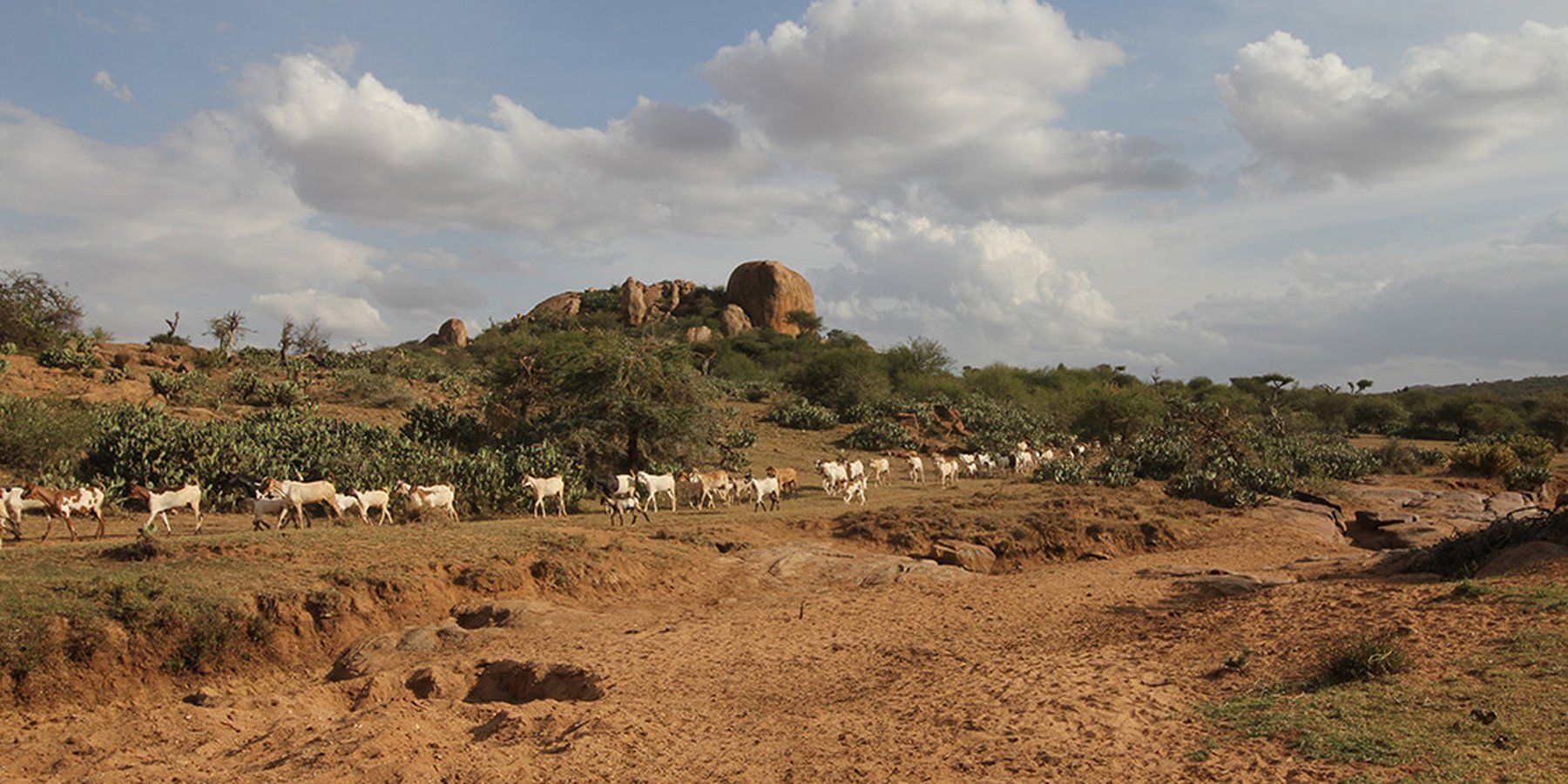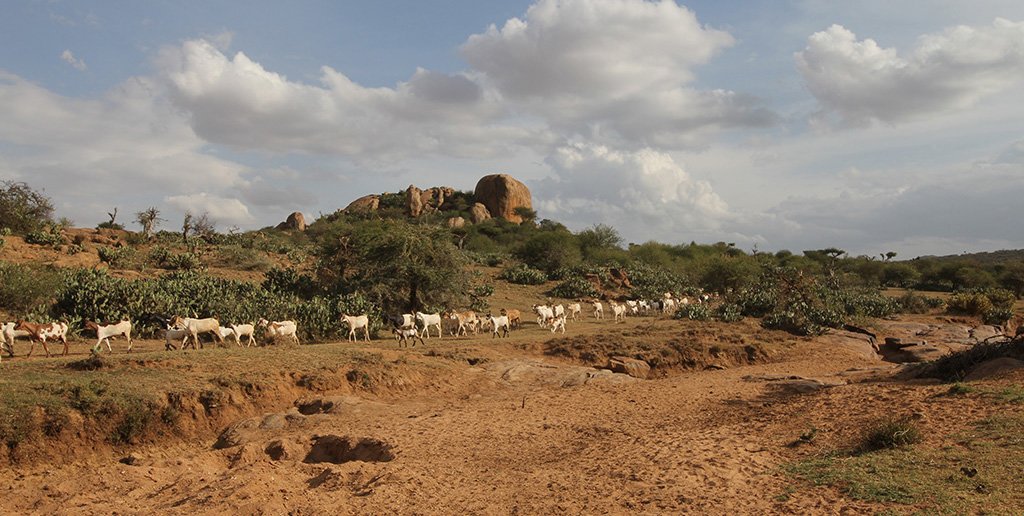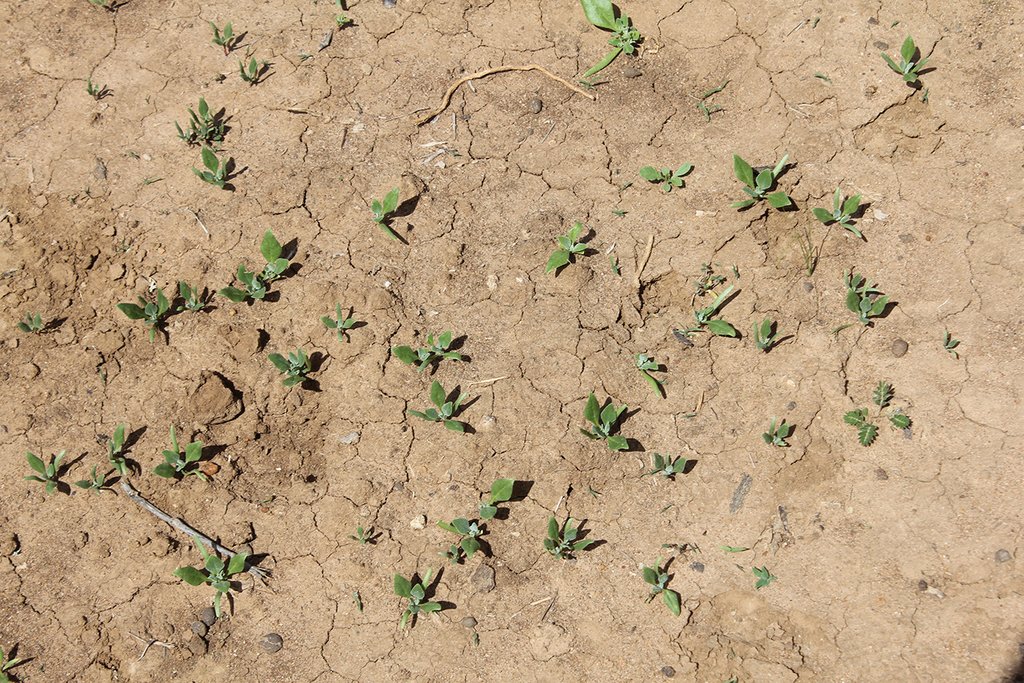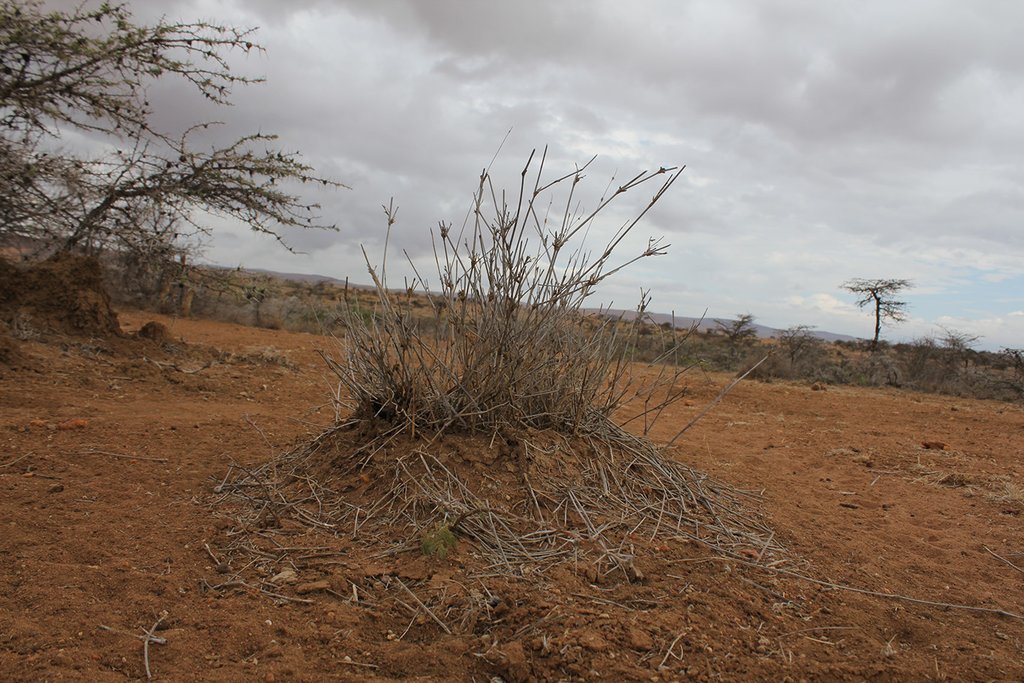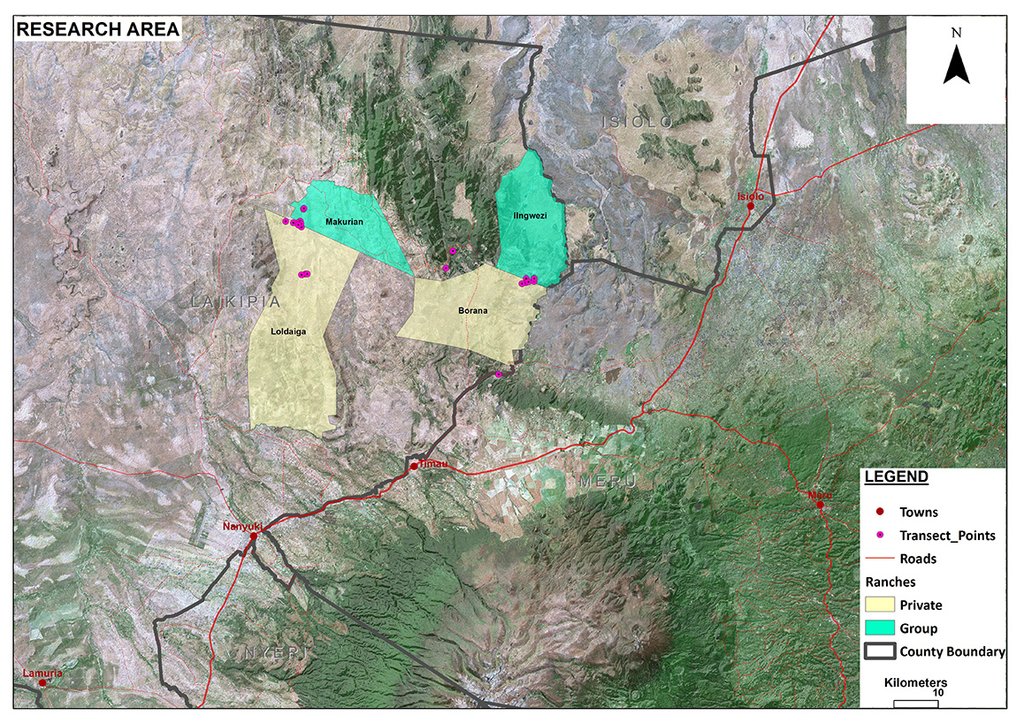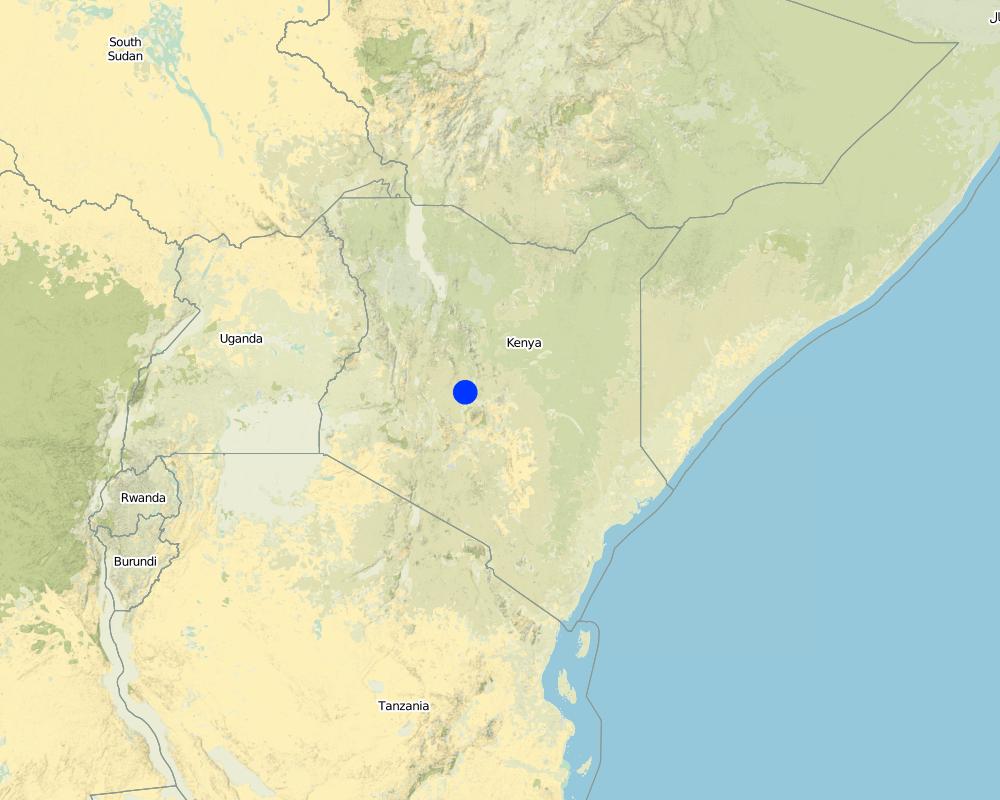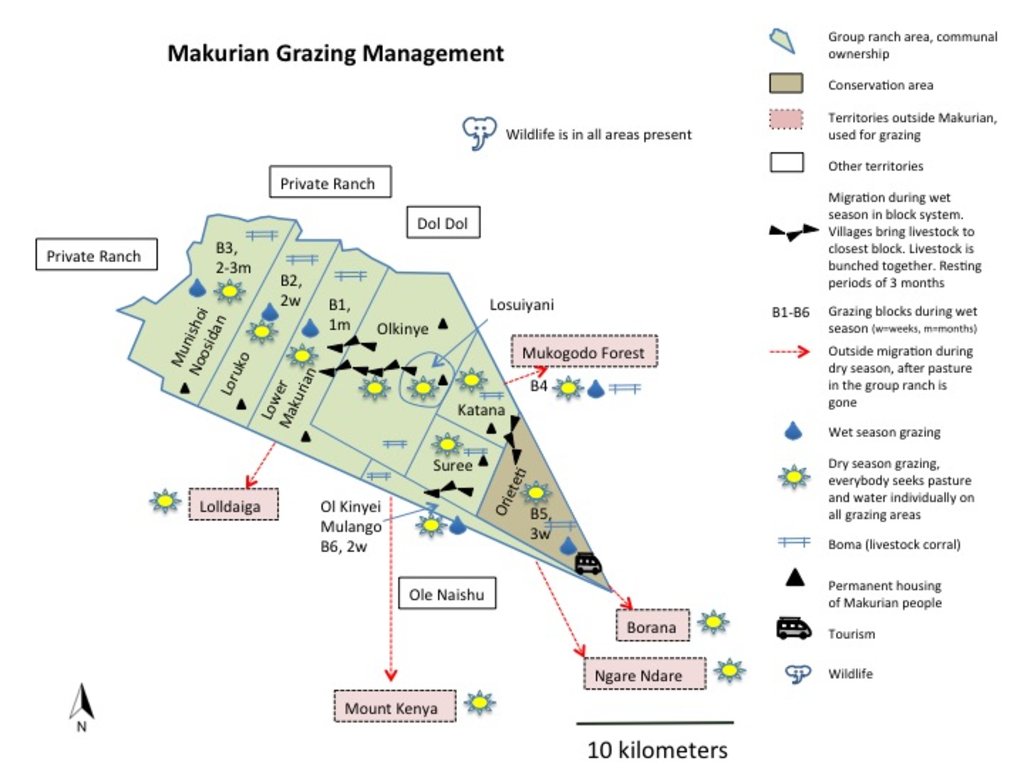Makurian Group Ranch Grazing with Holistic Management Principles [肯尼亚]
- 创建:
- 更新:
- 编制者: Michael Herger
- 编辑者: –
- 审查者: Rima Mekdaschi Studer
technologies_2990 - 肯尼亚
- Makurian Group Ranch Grazing with Holistic Management Principles: Feb. 1, 2018 (inactive)
- Makurian Group Ranch Grazing with Holistic Management Principles: Feb. 22, 2018 (inactive)
- Makurian Group Ranch Grazing with Holistic Management Principles: Sept. 3, 2018 (inactive)
- Makurian Group Ranch Grazing with Holistic Management Principles: May 9, 2019 (public)
查看章节
全部展开 全部收起1. 一般信息
1.2 参与该技术评估和文件编制的资源人员和机构的联系方式
关键资源人
土地使用者:
Sepeika Milton
+254 (0) 723870987
olenape@yahoo.com
Makurian Group Ranch
Mukogodo Division, Laikipia North District, Kenya
肯尼亚
1.3 关于使用通过WOCAT记录的数据的条件
(现场)数据是什么时候汇编的?:
22/01/2017
编制者和关键资源人员接受有关使用通过WOCAT记录数据的条件。:
是
1.4 所述技术的可持续性声明
这里所描述的技术在土地退化方面是否存在问题,导致无法被认为是一种可持续的土地管理技术?:
是
注释:
Makurian rangeland is in bad condition. The land is largely degraded and dominated by the invasive species "Opuntia". Makurian Group Ranch has abandoned the in 2007 implemented "Holistic Management" principles. However, one has to take into account that Masai pastoralists have historically been squeezed from all sides into smaller areas. Compare Herger (2018).
2. SLM技术的说明
2.1 技术简介
技术定义:
The grazing principles of a Masai group ranch (pastoralists) deal with high numbers of livestock in semi-arid lands with very limited water resources. Makurian has abandoned "Holistic Management" principles and applies a more traditional management system today. There is a grazing plan for the rains, while during the dry season everybody seeks for water and pasture individually. Bare land is recovered by "Boma” technology (strategic corralling of animals overnight) and reseeding. The rangeland is due to high stocking rates severely degraded with lots of erosion, bare ground, and invasive species. High stocking rates have on the one hand historical and political reasons and on the other hand socioeconomic rationales.
2.2 技术的详细说明
说明:
On Makurian Masai Group Ranch, livestock production management is through a combination of traditional livestock keeping practices and newly introduced management principles. Livestock production at Makurian is for subsistence and local use, and has very high cultural significance.
During the wet season, livestock are “bunched” together and rotational grazing in blocks is practiced. The management team group all livestock from each village (16 villages) and each uses the block next to their village. Livestock are hardly separated (cows, heifers, steers, bulls all herded together).
o Block 1: Lower Makurian - 1 month
o Block 2: Makurian Loruko - 2 weeks (next to Lolldaiga Northern Gate)
o Block 3: Munishoi Noosidan - 2-3 months
o Block 4: Mukogodo Forest - 1-2 months
o Block 5: Orieteti Conservation Area - 3 weeks. Soft grass, runs out quickly.
o Block 6: Ol Kinyei Mulango - 2 weeks. Next to Olenaisho
They apply resting periods of three months after usage (if this rule is broken, the owner is punished by a fine of one livestock unit).
When it becomes dry, everyone is responsible for their own livestock. Owners of livestock want to maintain and decide about their livestock individually, this is why "Holistic Management" and specific grazing plans for the dry season did not work.
In comparison to earlier days when the whole family moved, and livestock was herded by morans (young warriors), they hire external herders nowadays (800 herders in total). Herders seek whatever water and pasture remains on the group ranch, then move on to:
(a) Ngare Ndare forest: 1,000 cattle and 1,000 sheep and goats (shoats) per year on average, for 1-2 months, over an area of 250 km2;
(b) Mukogodo forest: 3,000 cattle and 4,000 shoats per year on average, for 3-4 weeks, over 250 km2, and
(c) Mount Kenya: 12,000 cattle and 5,000 shoats on average per year, for 1-2 months, on an undefined area.
In Mukogodo forest, Makurian Masai have also officially settled, in Ngare Ndare forest on the other hand they graze on the basis of an informal agreement and on Mount Kenya it is not official pasture - but grazing is tolerated). They are also assisted by private ranches to graze during droughts (Lolldaiga and Borana; for every 1,000 units, they usually pay 5 Ksh per cow per month: a token amount). On one private ranch (Borana) they also graze steers and cows for fattening and selling.
Furthermore, Laikipia rangelands support some of the highest densities of wildlife in Kenya, however, group ranches less so than private ranches. The wild herbivore biomass density on group ranches is by Georgiadis et al. (2007) estimated at 205 ha /TLU.
Bomas (corrals in Kiswahili) for the livestock are constructed in traditional style, where animals are kept closely bunched together in enclosures overnight. Bomas are strategically located on denuded land to rehabilitate the land (through dung accumulation and breaking the soil crust by hoof action). Every homestead has one boma (approximately 1,500 in total in the whole Group Ranch). When herders are moving with livestock, temporary bomas are constructed.
Sales are usually need-driven (e.g. for school fees) within a family. They sell to the nearest local markets (in DolDol and Nanyuki) or directly to butchers. Makurian is also part of the "Dung Market" in Mukogodo District, where livestock dung is sold as manure for crop production. Moreover, Makurian makes additional income by harvesting sand and selling it for construction.
2.3 技术照片
2.5 已应用该技术的、本评估所涵盖的国家/地区/地点
国家:
肯尼亚
区域/州/省:
Laikipia
有关地点的进一步说明:
Mukogodo Division
Map
×2.6 实施日期
如果不知道确切的年份,请说明大概的日期:
- 不到10年前(最近)
2.7 技术介绍
详细说明该技术是如何引入的:
- 通过土地使用者的创新
注释(项目类型等):
Holistic Management approach by Allan Savory was implemented in 2007, which was abandoned after a few years. This documentation focuses on the traditional system and new management principles they introduced since then. For Holistic Management see "Il Ngwesi" and "Borana" documentations.
3. SLM技术的分类
3.1 该技术的主要目的
- 改良生产
- 减少、预防、恢复土地退化
- 保护生态系统
- 保持/提高生物多样性
3.2 应用该技术的当前土地利用类型

牧场
粗放式放牧场:
- 半游牧/游牧
主要动物种类及产品:
Livestock: Cattle, goats, sheep, donkeys, camels. Meat and milk production (also blood) and as a bank/ value asset. Subsistence and local production. Livestock: 13,500 TLU, Stocking Rate 0.6 ha/TLU calculating the total area used by livestock (78 km2). Pressure on land (including wildlife density of 205 ha/TLU): 0.6 ha/TLU Livestock numbers: 15,000 cattle, 30,000 shoats (ratio goats - sheep 2:1) Livestock fluctuations (per year): -500 cattle sales, -4,000 shoats sales, +100 cattle purchase, +350 shoats purchase, -3,500 shoats slaughtered. +6,000 cattle, + 15,000 shoats due to natural breeding. On average, 2200 steers on Borana rangeland for fattening purpose. During droughts, livestock move to neighbouring private ranches (1,000 cows each on Lolldaiga and Borana on average) Wildlife: Giraffe, antelope/gazelle (e.g. gerenuk, impala, Thomson's gazelle), baboons, zebras, dikdik, hares, elephants, and more.

定居点、基础设施
- 定居点、建筑物
注释:
Villages, bomas, manyattas.
8'000 inhabitans.
3.3 有关土地利用的更多信息
该技术所应用土地的供水:
- 雨养
每年的生长季节数:
- 2
具体说明:
Short rains in November and December. Long rains in April and May. Rains from (October) November to December are usually better in this area. Rainfalls with strong local variations and changing regimes.
牲畜密度(如相关):
13’500 TLU, Stocking Rate 0.6 ha/TLU
3.4 该技术所属的SLM组
- 畜牧业和牧场管理
- 改良的地面/植被覆盖
3.5 技术传播
具体说明该技术的分布:
- 均匀地分布在一个区域
如果该技术均匀地分布在一个区域上,请注明覆盖的大致区域。:
- 10-100 平方千米
注释:
The area size of the group ranch is 68 km2, however, the total area affected by livestock is 78 km2.
3.6 包含该技术的可持续土地管理措施

管理措施
- M2:改变管理/强度级别
- M4:活动时间安排的重大变化
3.7 该技术强调的主要土地退化类型

土壤水蚀
- Wt:表土流失/地表侵蚀
- Wg:冲沟侵蚀/沟蚀

土壤风蚀
- Et:表土流失

物理性土壤退化
- Pc:压实
- Pk:熟化和结壳
- Pi:覆土

生物性退化
- Bc:植被覆盖的减少
- Bh:栖息地丧失
- Bq:数量/生物量减少
- Bs:质量和物种组成/多样性的下降
- Bl:土壤寿命损失
注释:
Across the grasslands and rangelands, an increase in bare land and bush has been a clear trend all over Laikipia for many years, both on community-owned lands and private ranches. Major identified ecological problems caused (partly) by livestock production in the research area are: major identified ecological problems (partly) caused by livestock production are: bare ground, low contents of soil organic carbon and plant-available nutrients, soil erosion (sealing, crusting, rills and gullies, water flow patterns, sheet erosion, pedestals), poor soil properties, undesirable species, and (increasing) woody and invasive species (Makurian is heavily affected by the invasion of Opuntia strica species). The current major problem on rangelands is the invasive species Opuntia stricta, which, however, only could spread that widely because of degraded land in the first place. The technology aims at improving vegetation cover of the land and thereby reducing further degradation and restoring degraded land.
3.8 防止、减少或恢复土地退化
具体数量名该技术与土地退化有关的目标:
- 减少土地退化
- 修复/恢复严重退化的土地
4. 技术规范、实施活动、投入和成本
4.1 该技术的技术图纸
4.3 有关投入和成本计算的一般信息
具体说明成本和投入是如何计算的:
- 每个技术区域
注明尺寸和面积单位:
Herders, animals treatment (for the total area affected by livestock = 78km2)
具体说明成本计算所用货币:
- 美元
注明雇用劳工的每日平均工资成本:
1.5
4.4 技术建立活动
| 活动 | 措施类型 | 时间 | |
|---|---|---|---|
| 1. | Grazing planning for bunched animals (livestock from all households) | 管理 | |
| 2. | Hiring herders, supervisors, watchmen etc | 管理 |
4.5 技术建立所需要的费用和投入
| 对投入进行具体说明 | 单位 | 数量 | 单位成本 | 每项投入的总成本 | 土地使用者承担的成本% | |
|---|---|---|---|---|---|---|
| 劳动力 | unknown |
4.6 维护/经常性活动
| 活动 | 措施类型 | 时间/频率 | |
|---|---|---|---|
| 1. | Herders, supervisors, watchmen etc | ||
| 2. | Animal treatments (vaccination, spraying, injections) | ||
| 3. | Planning activites | ||
| 4. | Boma Management (mainly movement of Bomas) |
4.7 维护/经常性活动所需要的费用和投入(每年)
| 对投入进行具体说明 | 单位 | 数量 | 单位成本 | 每项投入的总成本 | 土地使用者承担的成本% | |
|---|---|---|---|---|---|---|
| 劳动力 | Herders, watchmen, supervisors | Person-days | 260000.0 | 1.5 | 390000.0 | |
| 劳动力 | Engaged population in livestock production | 720000.0 | 1.5 | 1080000.0 | ||
| 其它 | Animals treatments | Per TLU | 13500.0 | 3.5 | 47250.0 | |
| 技术维护所需总成本 | 1517250.0 | |||||
注释:
Every family hires their own herder during the dry season. The family is staying put. Inhabitants are also considered as labor since they are usually all engaged in livestock production. However, milk and blood production are not considered.
Animal treatments consist of vaccination, spraying (ticks), injections.
4.8 影响成本的最重要因素
描述影响成本的最决定性因素:
Herders
5. 自然和人文环境
5.1 气候
年降雨量
- < 250毫米
- 251-500毫米
- 501-750毫米
- 751-1,000毫米
- 1,001-1,500毫米
- 1,501-2,000毫米
- 2,001-3,000毫米
- 3,001-4,000毫米
- > 4,000毫米
指定年平均降雨量(若已知),单位为mm:
378.00
有关降雨的规范/注释:
Strong local (and temporal) variation, changing rainfall regimes. Makurian generally drier than Lolldaiga.
注明所考虑的参考气象站名称:
Rainfall gauge Lolldaiga Northern Gate (neighbouring ranch)
农业气候带
- 半干旱
5.2 地形
平均坡度:
- 水平(0-2%)
- 缓降(3-5%)
- 平缓(6-10%)
- 滚坡(11-15%)
- 崎岖(16-30%)
- 陡峭(31-60%)
- 非常陡峭(>60%)
地形:
- 高原/平原
- 山脊
- 山坡
- 山地斜坡
- 麓坡
- 谷底
垂直分布带:
- 0-100 m a.s.l.
- 101-500 m a.s.l.
- 501-1,000 m a.s.l.
- 1,001-1,500 m a.s.l.
- 1,501-2,000 m a.s.l.
- 2,001-2,500 m a.s.l.
- 2,501-3,000 m a.s.l.
- 3,001-4,000 m a.s.l.
- > 4,000 m a.s.l.
5.3 土壤
平均土层深度:
- 非常浅(0-20厘米)
- 浅(21-50厘米)
- 中等深度(51-80厘米)
- 深(81-120厘米)
- 非常深(> 120厘米)
土壤质地(表土):
- 粗粒/轻(砂质)
- 中粒(壤土、粉土)
土壤质地(地表以下> 20厘米):
- 粗粒/轻(砂质)
- 中粒(壤土、粉土)
表土有机质:
- 低(<1%)
如有可能,附上完整的土壤描述或具体说明可用的信息,例如土壤类型、土壤酸碱度、阳离子交换能力、氮、盐度等。:
Red and brown sandy soils. Black cotton soil. Luvisol, Regosol, Vertisol
SOC 0.8 %
pH: 6.4
Clay: 9 %
Silt: 41 %
Sand: 50 %
Fore more data on rangeland health see Herger (2018)
5.4 水资源可用性和质量
地下水位表:
> 50米
地表水的可用性:
中等
水质(未处理):
不良饮用水(需要处理)
水的盐度有问题吗?:
否
该区域正在发生洪水吗?:
否
5.5 生物多样性
物种多样性:
- 中等
栖息地多样性:
- 低
关于生物多样性的注释和进一步规范:
Grassed acacia bushland. Bare land up to 70% during dry season. Loss of (native) vegetation. Invasive species coming in. Dominant grasses: Eragrostis species, Cynadon species, Hyparrhenia species, Kelenger species. Dominant shrubs: Opuntia, Lyceum europaeum, Barleria acuthodies. Dominant trees: Acacia drepanolobium, Acacia etbaica. Detailed list of all species (also wildlife) available (see Herger 2018).
5.6 应用该技术的土地使用者的特征
定栖或游牧:
- 半游牧的
生产系统的市场定位:
- 混合(生计/商业
非农收入:
- 低于全部收入的10%
相对财富水平:
- 贫瘠
个人或集体:
- 个人/家庭
- 团体/社区
机械化水平:
- 手工作业
性别:
- 女人
- 男人
土地使用者的年龄:
- 青年人
- 中年人
说明土地使用者的其他有关特征:
Masai people. 8'000 Masai living in Makurian. Traditional livestyle. Livestock with very high cultural value.
Have been historically "squeezed" from all sides into smaller areas for livestock keeping. Future of pastoralism is in question.
5.7 应用该技术的土地使用者拥有或租用的平均土地面积
- < 0.5 公顷
- 0.5-1 公顷
- 1-2 公顷
- 2-5公顷
- 5-15公顷
- 15-50公顷
- 50-100公顷
- 100-500公顷
- 500-1,000公顷
- 1,000-10,000公顷
- > 10,000公顷
这被认为是小规模、中规模还是大规模的(参照当地实际情况)?:
- 小规模的
注释:
This applies for households that are staying put. Herders trek livestock on a total area of over 10'000 ha.
5.8 土地所有权、土地使用权和水使用权
土地所有权:
- 社区/村庄
土地使用权:
- 社区(有组织)
用水权:
- 自由进入(无组织)
5.9 进入服务和基础设施的通道
健康:
- 贫瘠
- 适度的
- 好
教育:
- 贫瘠
- 适度的
- 好
技术援助:
- 贫瘠
- 适度的
- 好
就业(例如非农):
- 贫瘠
- 适度的
- 好
市场:
- 贫瘠
- 适度的
- 好
能源:
- 贫瘠
- 适度的
- 好
道路和交通:
- 贫瘠
- 适度的
- 好
饮用水和卫生设施:
- 贫瘠
- 适度的
- 好
金融服务:
- 贫瘠
- 适度的
- 好
6. 影响和结论性说明
6.1 该技术的现场影响
社会经济效应
生产
饲料生产
注释/具体说明:
Lack of rain. Impact analysis is comparing the current state vs. some 10 years ago when they applied Holistic Management. This is why improvements are indicated according to the land user, even though the land is severely degraded.
饲料质量
畜牧生产
土地管理
水资源可用性和质量
饮用水的可用性
饮用水的质量
注释/具体说明:
less salt
家畜用水的可用性
家畜用水的质量
收入和成本
工作量
注释/具体说明:
Compared to HM it has decreased, because of higher numbers of livestock it has increased though
社会文化影响
食品安全/自给自足
土地使用权/用水权
SLM/土地退化知识
注释/具体说明:
More traditional knowledge than with Holistic Management
冲突缓解
注释/具体说明:
Other communities
生态影响
水循环/径流
水量
水质
地表径流
注释/具体说明:
Opuntia
地下水位/含水层
蒸发
生物多样性:植被、动物
植被覆盖
注释/具体说明:
Opuntia (an invasive cactus) is chasing out native plants and consuming water. Elephants are destroying trees (high density of elephants, Opuntia is additionally attracting elephants)
植物多样性
注释/具体说明:
Opuntia
动物多样性
注释/具体说明:
More wildlife coming in, roaming even in villages. Elephants problematic; breaking fences
栖息地多样性
注释/具体说明:
Wildlife numbers are declining drastically. Indigenous vegetation is being driven out by invasive species like Opuntia.
减少气候和灾害风险
干旱影响
注释/具体说明:
Resilience has worsened
6.2 该技术的场外影响已经显现
有关影响评估的意见:
All listed impacts are as perceived by land users according to Milton Sepeika, Chief of Makurian. In his opinion, abandoning Holistic Management principles had many advantages. According to him, animal production has increased. Though he recognices the bad condition of the land and poor conditon of livestock. He mainly blames the drought and the Opuntia invasion for these problems. Results from a rangeland health assessment (only ecological conditions) show heavily degraded ecological conditions (dry season up to 70% bare soil, poor soil and vegetation, erosions features, inability of producing annual and perennial grasses after rains etc) (compare Herger 2018). A
6.3 技术对渐变气候以及与气候相关的极端情况/灾害的暴露和敏感性(土地使用者认为的极端情况/灾害)
渐变气候
渐变气候
| 季节 | 气候变化/极端天气的类型 | 该技术是如何应对的? | |
|---|---|---|---|
| 其他渐变气候 | Greater variation of seasonal rainfall, more intense rainfalls, change in rainfall regimes in general (see Schmocker 2013 and Imfeld 2016). | 增加 | 不好 |
气候有关的极端情况(灾害)
气候灾害
| 该技术是如何应对的? | |
|---|---|
| 热浪 | 不好 |
6.4 成本效益分析
技术收益与技术建立成本相比如何(从土地使用者的角度看)?
短期回报:
消极
长期回报:
轻度消极
技术收益与技术维护成本/经常性成本相比如何(从土地使用者的角度看)?
短期回报:
消极
长期回报:
轻度消极
6.5 技术采用
- 1-10%
在所有采用这项技术的人当中,有多少人是自发地采用该技术,即未获得任何物质奖励/付款?:
- 0-10%
6.6 适应
最近是否对该技术进行了修改以适应不断变化的条件?:
是
若是,说明它适应了哪些变化的条件:
- 气候变化/极端气候
具体说明技术的适应性(设计、材料/品种等):
Masai people have changed their livestock composition towards owning more smallstock (goats and sheep) than cattle. Goats are tolerant to drought, and as browsers they don't need grass. They can be turned into money much quicker than a cow in times of need. Their faster reproductive cycle means they can rebuild numbers faster than cattle after losses through drought.
6.7 该技术的优点/长处/机会
| 土地使用者眼中的长处/优势/机会 |
|---|
| Everybody makes their own decision about their livestock (during the dry season). Owners stay in charge. |
| Grazing principles and plans lead to community control. |
| Traditional knowledge |
| Fewer costs |
| Less of effort (during the dry season no bunching of animals) |
| Fewer trees cut. During Holistic Management times many trees had to be cut to create two big bomas every month. |
| Can enrich land, livestock is tilling ground (seeds don't go away - kept in ground due to "tilling") |
6.8 技术的弱点/缺点/风险及其克服方法
| 土地使用者认为的弱点/缺点/风险 | 如何克服它们? |
|---|---|
| Brings in conflicts. If you start to protect and maintain your grass, thieves come in. | |
| Spread of diseases when animals from different places with different diseases are brought together during the wet season |
7. 参考和链接
7.1 信息的方法/来源
- 实地考察、实地调查
4 field visits with included "rangeland health assessment" in different parts of Makurian (mostly next to Lolldaiga Northern Gate) where I could see the condition of the land as well as several other visits of the area.
- 与土地使用者的访谈
Several meetings with chief, rangeland specialist and botanist of Makurian.
- 与SLM专业人员/专家的访谈
Truman Young
Dan Rubenstein
Dino Martins
John Letai
Samali Letai
Peter Hetz
Dominic Maringa
Joseph Putunoi
Patrick Ekodere
- 根据报告和其他现有文档进行编译
Scientific papers, LWF reports etc.
7.2 参考可用出版物
标题、作者、年份、ISBN:
Imfeld, N. (2016). Modeling Seasonal and Annual Precipitation using long-term Climate Records and Topography. MSc Thesis. University of Bern.
可以从哪里获得?成本如何?
Online
标题、作者、年份、ISBN:
Herger, M.B. (2018). Environmental Impacts of Red Meat Production. MSc Thesis. University of Bern.
可以从哪里获得?成本如何?
University of Bern
标题、作者、年份、ISBN:
Georgiadis, N.J., Olivero, I.N., Romanach, S.S. (2007). Savanna herbivore dynamics in a livestock-dominated landscape: I. Dependence on land use, rainfall, density, and time. Biology Conservation 137(3): 461-472.
可以从哪里获得?成本如何?
Online
链接和模块
全部展开 全部收起链接
无链接
模块
无模块


